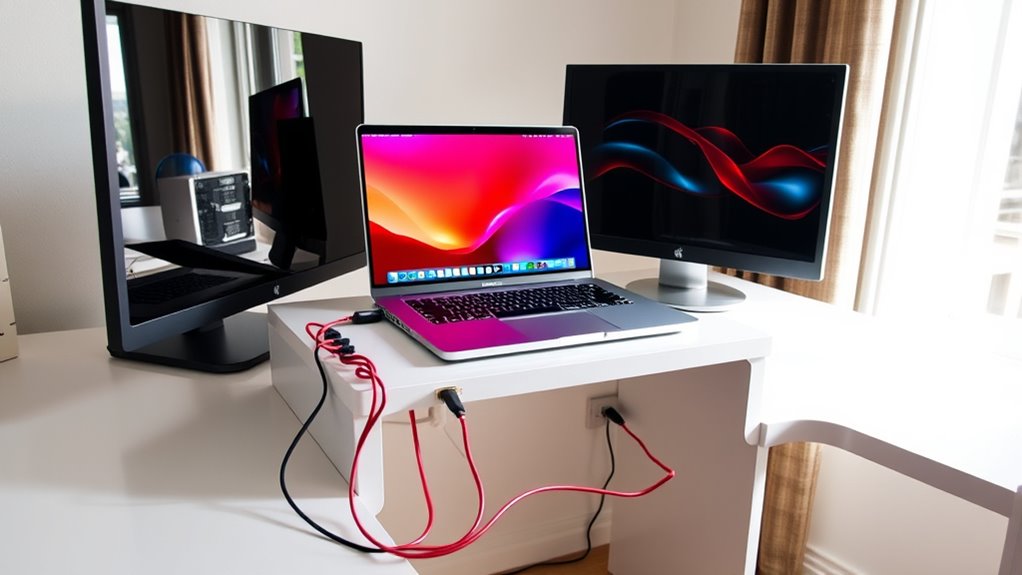To connect two monitors to your laptop, first check its specifications for graphics capabilities and available ports like HDMI or DisplayPort. Gather the necessary cables or adapters, ensuring compatibility. Connect the monitors by plugging cables into the laptop and each monitor, then power them on. Next, configure display settings for arrangement, resolution, and primary display. For an optimized setup, consider ergonomics and application placement. You’ll find more tips just ahead for a seamless dual-monitor experience.
Check Your Laptop’s Compatibility
How can you guarantee your laptop supports multiple monitors? First, check your laptop specifications, particularly the graphics card capabilities. Look for options like HDMI, DisplayPort, or USB-C, which indicate external display options. If your laptop has a dedicated GPU, it’s more likely to handle multiple displays efficiently. Next, assess the maximum supported resolution and refresh rate for each external monitor. Many laptops can support two monitors, but limitations vary based on hardware and software configurations. Consult the manufacturer’s website or user manual for details on compatibility. Ensuring your laptop can accommodate the desired setup not only enhances productivity but also grants you the freedom to create a more expansive workspace tailored to your needs.
Gather Necessary Cables and Adapters
Before you can set up your dual monitor display, you’ll need to gather the appropriate cables and adapters. Understanding the right cable types and adapter options is vital for a seamless connection. Here’s a quick list of what you might need:
To set up a dual monitor display, gather the necessary cables and adapters for a seamless connection.
- HDMI or DisplayPort Cables: Confirm you have the correct length to reach your monitors.
- USB-C or Thunderbolt Adapters: If your laptop lacks standard ports, these adapters can bridge the gap.
- VGA or DVI Cables: Older monitors may require these, so check your equipment.
Having these essentials on hand will empower you to create your multi-monitor setup efficiently. Be certain to double-check compatibility before purchasing to avoid any potential issues.
Connect the Monitors to Your Laptop
Once you’ve gathered all necessary cables and adapters, connecting the monitors to your laptop is straightforward. Depending on your monitor types, you might use HDMI, DisplayPort, VGA, or DVI connections. First, plug one end of the cable into the laptop and the other into the first monitor. For a second monitor, repeat the process using an available port. If your laptop has limited ports, consider using a USB-C to HDMI adapter or a docking station to expand your connection options. Make sure that both monitors are powered on. With everything securely connected, you’re ready for the next steps in optimizing your dual-monitor setup. Enjoy the freedom of increased screen real estate for your multitasking needs!
Configure Display Settings
Configuring display settings for your dual-monitor setup is essential for top performance. Here’s how to get it right:
- Adjust Display Arrangement: Go to your display settings and drag the monitor icons to match your physical setup. This guarantees smooth movement between screens.
- Set Screen Resolution: Select the best resolution for each monitor. Right-click on the desktop, choose display settings, and verify each monitor uses its native resolution for clarity.
- Choose Primary Display: Decide which monitor will be your main one. This will dictate where your taskbar and primary applications appear.
Optimize Your Dual Monitor Setup
To get the most out of your dual monitor setup, you’ll want to optimize various aspects, ensuring a seamless and productive experience. Start by positioning your monitors at eye level for comfort. Utilize the dual display advantages by assigning specific tasks to each screen—keep your primary work on one and supplementary tasks on the other. Implementing effective workspace organization is essential; consider using tools like window management software to help arrange your applications efficiently. Customize your display settings—adjust resolution, scaling, and orientation to match your needs. Finally, regularly declutter your desktop to maintain focus and productivity. By optimizing these elements, you’ll fully harness the potential of your dual monitor configuration, enhancing both your workflow and creativity.
Frequently Asked Questions
Can I Use Different Monitor Brands Together?
Yes, you can use different monitor brands together. Just verify they have compatible resolutions and connections. Mixed brands typically work well, but monitor compatibility is essential for peak performance and a seamless experience.
What if My Laptop Doesn’t Support Dual Monitors?
If your laptop doesn’t support dual monitors, consider laptop upgrades or using external adapters like USB to HDMI. These solutions can help you expand your display options, enhancing your productivity and freedom in multitasking.
Will Using Two Monitors Drain My Laptop Battery Faster?
Sure, using two monitors’ll make your laptop’s battery consumption soar like a rocket! But fear not; with savvy power management, you can still enjoy your dual-display freedom without sending your battery into a tailspin.
How Do I Switch Between Monitors Easily?
To switch between monitors easily, use monitor shortcuts like Windows+P. You can also access display settings to adjust configurations. This lets you quickly toggle between extended and duplicate displays, enhancing your multitasking experience.
Can I Extend My Display to a TV Instead?
Absolutely, you can extend your display to a TV. Just adjust your display settings and connect wirelessly. It’s like opening a window to fresh air, giving you freedom to work or play on a bigger screen.

